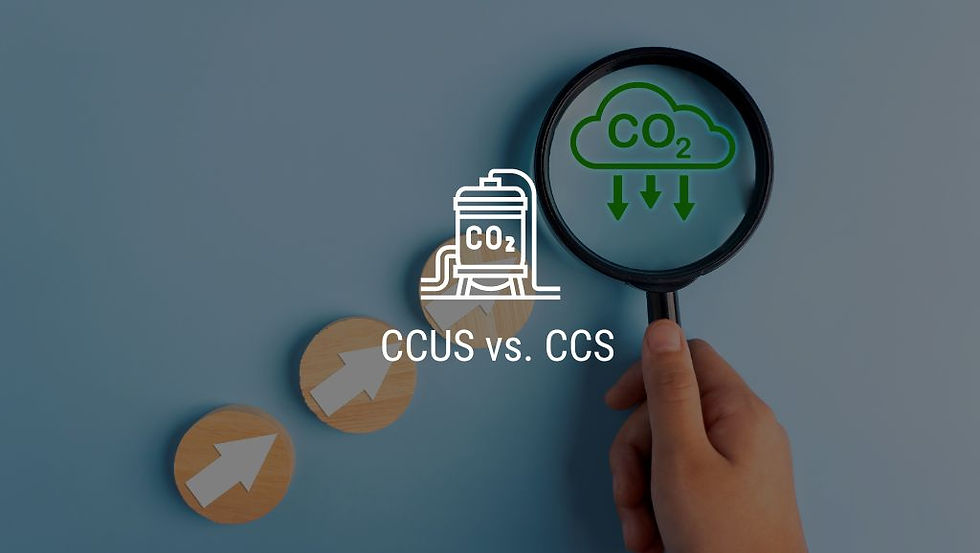CCUS vs. CCS
- Craig Kaiser
- Sep 13, 2024
- 4 min read

Carbon Capture, Utilization, and Storage (CCUS) is an advanced iteration of the traditional Carbon Capture and Storage (CCS) technology. While CCS focuses mainly on the capture and sequestration of carbon dioxide to mitigate emissions, CCUS takes a step further by finding practical applications for the captured carbon. This makes CCUS a more dynamic approach as it not only reduces the greenhouse gases released into the atmosphere but also turns them into valuable products like chemicals, concrete, and even fuels. In this guide, we will explore the differences between CCUS and CCS, highlighting the future of each practice.
Key Takeaways:
CCUS vs. CCS: CCUS (Carbon Capture, Utilization, and Storage) is an advanced form of CCS (Carbon Capture and Storage) that not only captures and stores carbon dioxide but also finds practical uses for it, turning it into valuable products like chemicals and fuels.
Carbon Capture: This involves capturing CO2 emissions from power plants and industrial facilities to prevent their release into the atmosphere, thereby mitigating global warming.
CCS Process: CCS involves capturing CO2, transporting it to a storage site, and securely storing it to prevent atmospheric release, thus combating climate change.
CCUS Process: CCUS goes beyond CCS by reusing captured CO2 in industrial processes, converting it into materials like plastics and biofuels, making it a more efficient approach to managing emissions.
Challenges: High costs and developmental challenges hinder widespread CCS adoption. Without legislative mandates or financial incentives, companies have little motivation to invest in this technology.
Future Prospects: CCUS is gaining momentum due to national climate targets and policy incentives. Significant investments, like the $1.2 billion by the DOE in 2023, aim to expand carbon removal infrastructure.
Opportunities for Landowners: Property owners can lease land for carbon storage or credits, contributing to CCS operations and benefiting from carbon capture initiatives.
What is Carbon Capture?
Carbon capture encompasses a range of techniques employed to capture the carbon dioxide (CO2) emissions generated by power plants and industrial facilities. Its primary objective is to prevent the release of CO2 into the atmosphere, which contributes to global warming. Once captured, the carbon dioxide can either be repurposed for other uses or securely stored, a process known as carbon sequestration. This approach not only mitigates environmental impact but also ensures the responsible management of CO2 emissions.
What is Carbon Capture and Storage (CCS)?
Carbon capture and storage (CCS) is a unique technological process aimed at mitigating the release of large amounts of CO2 into the atmosphere, thereby combating climate change. The process involves three key steps: the capture of CO2 emissions, the transportation of the captured CO2 to a suitable storage site, and the secure storage of the CO2 to prevent its release into the atmosphere. This innovative approach ensures that CO2 is effectively contained and does not contribute to environmental degradation.
What is Carbon Capture, Utilization & Storage (CCUS)?
Carbon Capture, Utilization, and Storage (CCUS) takes CCS one step further. Working in unison with CCS is CCUS, which focuses on reusing the CO2 from industrial processes by converting it into productive goods.
CCUS vs. CCS
Instead of just trapping and burying carbon dioxide using carbon capture and storage (CCS), certain technologies enable its productive utilization. This process, known as carbon capture, utilization, and storage (CCUS), allows for a more efficient and effective approach to managing carbon emissions. The idea for CCUS is that, instead of just storing carbon, it could be re-used in industrial processes by converting it into productive materials, such as plastics, concrete or biofuel.
Why Is Carbon Capture Not Used More?
The widespread adoption of CCS development has been hindered by several factors. One primary obstacle is the high cost associated with implementation. Unless polluters are compelled by legislation or offered financial incentives by the government, they have little incentive to invest in this technology, except to maintain their reputation as responsible corporate entities.
Additionally, much of the technology, especially direct air capture, is still in the developmental phase. It is energy intensive, slow to implement, and unproven and scale, which has slowed its adoption. Nevertheless, it is highly probable that carbon capture will play a more prominent role in the future.
The Future of CCS and CCUS
CCUS is not a new idea, but the pipeline is now growing exponentially on the back of national climate targets and policy incentives which have encouraged rapid up-scaling and wide-scale adoption. For example, the 2021 Infrastructure Investment and Jobs Act allocated more than $12 billion for CCUS projects. In August 2023, the Department of Energy (DOE) announced that it was investing up to $1.2 billion in two commercial-scale direct air capture facilities, one in Louisiana and the other in Texas. The DOE said the investment “aims to kickstart a nationwide network of large-scale carbon removal sites to address legacy carbon dioxide pollution and complement rapid emissions reductions.
Property owners across the United States may have the opportunity to contribute to CCS operations by leasing their property for carbon storage. Landowners can also lease their land for carbon credits, agreeing to certain practices that allow their land to capture more carbon. To lease land for carbon credits, consider listing your property for lease for free on LandGate's marketplace, where high-intent carbon developers and investors actively source new projects: